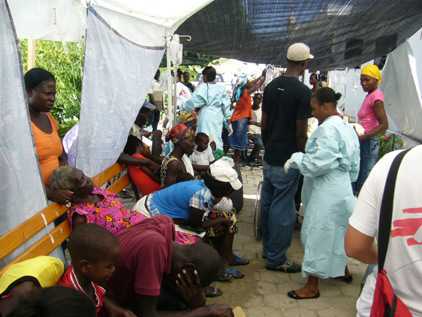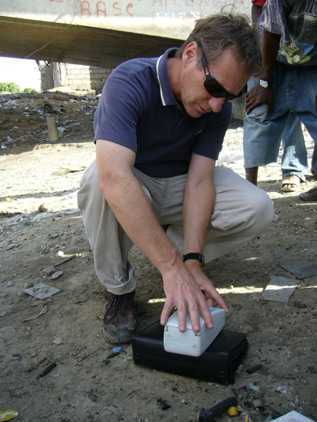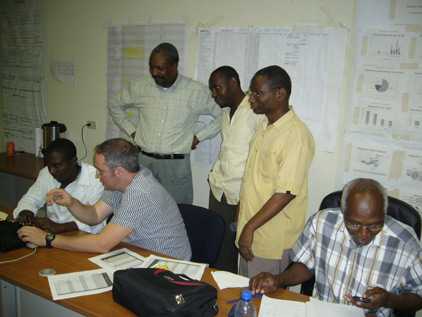Public Health in Haiti: Saving Lives, Controlling the Spread of Cholera
This website is archived for historical purposes and is no longer being maintained or updated.
Related Pages

CDC is working with Haiti’s Ministry of Public Health and Population to prevent deaths in health facilities and in communities. Response teams conduct site inspections at hospitals and community facilities to assess their capacity to take in the influx of patients presenting with suspected cholera. CDC also is working to ensure proper clinical treatment and adequate supplies are in place. As of early November, CDC teams have traveled to 47 facilities to assess the situation. Shown here is St. Marc’s Hospital, where the most seriously ill patients have been triaged to clinicians and others wait to be seen.
The top priority of the public health response is to save lives and control the spread of disease. CDC’s assistance to the Haiti Ministry of Public Health and Population is focusing on the following areas:
- increasing access to life-saving oral and IV rehydration therapy
- improving access to safe water, sanitation, and hygiene supplies
- establishing a national surveillance system for accurate and timely identification of cholera cases
- consulting on clinical management and treatment of patients with cholera, and advising on ways to prevent cholera among those who don’t have it
- performing laboratory testing of suspected cholera cases in collaboration with Haiti’s National Public Health Laboratory
- conducting environmental health assessments, such as testing of the water supply, in various communities throughout the country
- carrying out site inspections at hospitals and clinics to assess their capacity to deliver health care
- conducting epidemiologic surveys and studies to find out more about the outbreak and how to contain it
- planning and conducting cholera training for clinical staff and community health workers
- developing guidelines for household infection control for possible cases of cholera brought into the United States
- developing messages in support of cholera prevention and control efforts (including information translated into French, Creole, and Spanish)
- working with partners to monitor the progress of Tropical Storm Tomas and consult about potential impact that the storm could have on the response to the outbreak.

CDC is using science to direct prevention and control efforts, such as testing the water supply in various settings, including urban areas and camps for displaced persons to learn how cholera infection in Haiti is spreading. Pictured is CDC’s Tom Handzel collecting water samples for testing to see if household water contains chlorine.
On November 1, CDC provided the Haitian government with the results of laboratory testing showing that the cholera strain linked to the outbreak is most similar to cholera strains found in South Asia. More work is needed to determine the origin of the cholera strain in Haiti.

The identification and location of cholera cases is being monitored through Haiti’s National Cholera Monitoring System (NCMS). Pictured is CDC’s Ezra Barzilay (second from left), working with country partners to set up a nationwide database that will help track cholera cases.
CDC’s response to the outbreak is being coordinated through its Emergency Operations Center in Atlanta, and CDC experts have been deployed to Haiti and the Dominican Republic to provide in-country assistance. A total of 183 staff were participating in the outbreak, including 25 who were deployed as of December 10. Among those involved in the response are medical officers, epidemiologists, laboratory scientists, environmental health specialists, communication specialists, public health advisors, planners, information technology specialists, and support staff. The Global Aids Program (GAP), which opened CDC’s first office in Haiti in 2002 to support the Government of Haiti in addressing their HIV/AIDS epidemic, has been critical in the coordination of responses to both the earthquake and cholera outbreak. The office has more than 40 staff members, most of whom are locally employed.
- Page last reviewed: October 29, 2014 (archived document)
- Content source:


 ShareCompartir
ShareCompartir